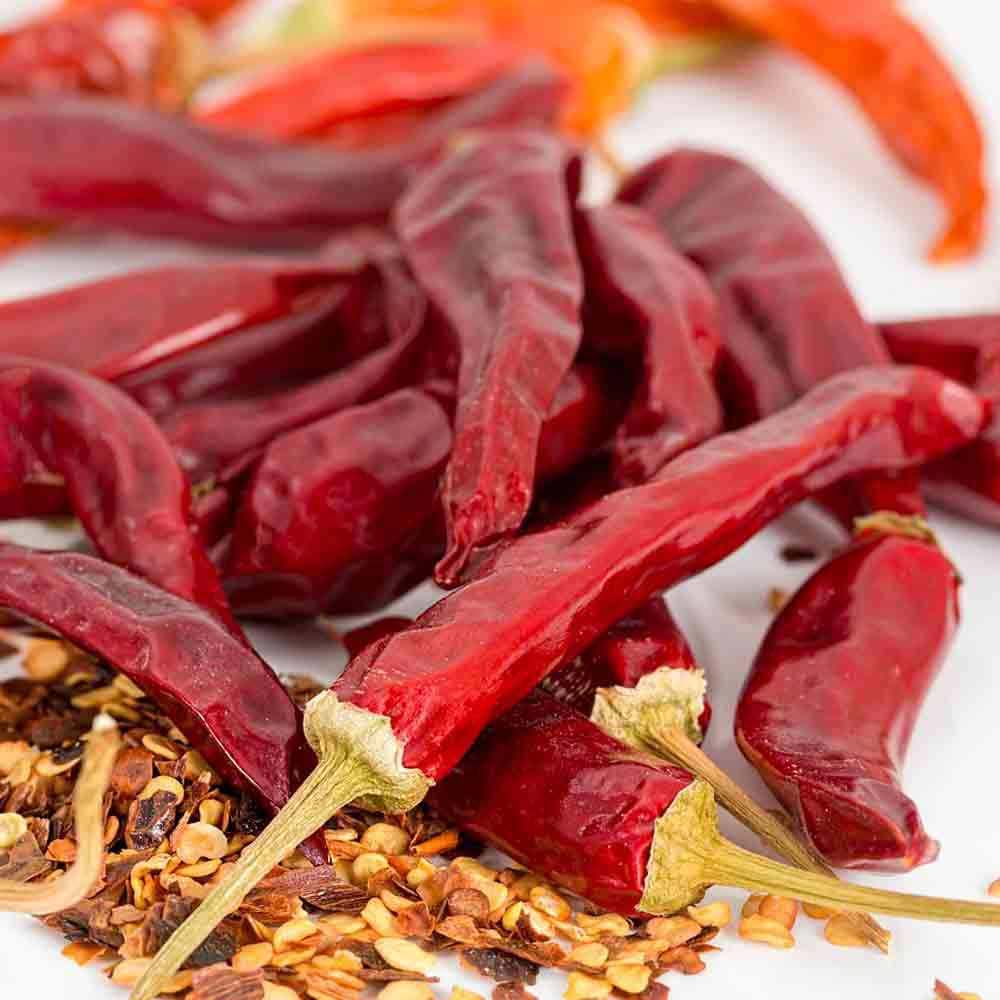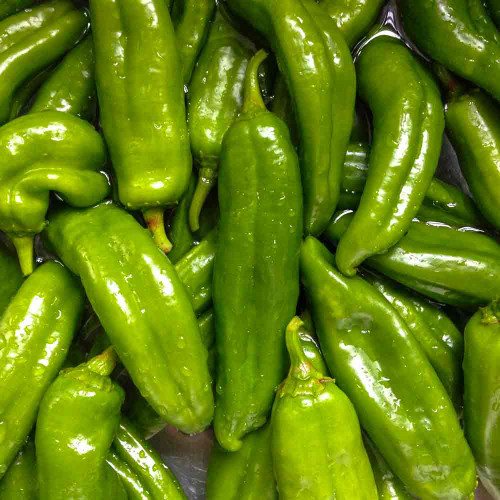Description
Paprika Jackson Pepper - Mild, Yet Bold Southwest Paprika
Paprika Jackson’s sweet, mild warmth was almost lost just over a decade ago. Fortunately, a chile pepper breeder from southern Arizona who values flavor over heat, passionately worked to preserve this variety and even improved it in the process.
The story starts with a commercial chile pepper breeder who supplied the corporate food industry with sweet paprika peppers as a coloring agent for meats, cheeses, popcorn oil, and even specific lipstick colors.
Somewhere along the way, Paprika Jackson developed some character – a personality, if you will – that was undesirable in the industrial food sector. That character was a subtle heat, just enough warmth to be noticeable but not enough spice for the hot paprika market and too much warmth for the sweet paprika industry.
That left Jackson as an unwanted cultivar in a commercial business, and the breeder was abandoning it when one of our chile growers heard about it during a chile pepper conference.
After learning about what was considered a stubborn and undesirable paprika pepper, he took it in to see what the fuss was about. He grew it out, liked the combination of flavor with a slight touch of heat, and decided to keep it. Like us, he always chooses flavor as a prime characteristic in his breeding.
He and his crew grew it out, only selecting a few plants that had the best growth and pepper shape with the elusive flavor they were looking for – rich and sweet with just a hint of heat as it dried down, making it perfect to finish drying over a slow mesquite or oak smoke to add complexity and deepen the flavor.
After seven or eight years, the dominant flavor profiles they selected for had stabilized, and they began growing for production while still testing and saving the best seeds from the highest quality plants.
Now, we are proud to offer this “undesirable” misfit of a southwestern paprika pepper that had the audacity to develop a personality in a commercial commodity environment. Thanks to our grower, it has a deep, rich red color matched by its sweet flavor and excellent production.
You won’t find this pepper anywhere else, and we count ourselves lucky to know someone as persistent, dedicated, and passionate about chile peppers as our grower, who introduced us to Paprika Jackson.
Details
Paprika Jackson plants bear a striking resemblance to other New Mexican chiles, making them hard to tell apart at first glance – with their single, strong main stem with regular branching that gives good foliage cover, reducing sunscald and supporting excellent fruit set. Mature plants usually reach 24 - 30” tall and up to 2’ wide.
As chiles mature, they transform from bright, almost lime green through a deeper dark green before finally becoming a deep, rich red that is almost black. The pods typically have a slightly rough, wrinkled surface when dry. They gradually narrow from the stem to the blossom end and have rounded shoulders.
As the fruits ripen on the vine, their unique flavors gradually develop, but it's not until they begin to dry that their true character is revealed. It's during this process that their slightly smoky yet sweet taste with just a hint of warmth really comes to life, providing a truly delightful culinary experience.
Paprika Jackson has just a touch of heat – very slightly more than traditional sweet paprika, enough to notice its mellow warmth without becoming uncomfortable. Sweet paprika has no heat, just the flavor of ripe peppers and is ideal for anyone wanting to add pepper flavor to their food but without the heat.
Chile peppers get their spice from capsaicinoids, which are natural chemicals found in tiny yellow droplets along the inside veins of the pepper. The amount of these spicy compounds can change based on things like how much water the soil gets, if the pepper has some shade in the afternoon, and how hot the weather is. The heat of your chile pepper depends on a mix of these environmental factors.
History
The best place to start looking at the history of paprika is by defining what, exactly, paprika is.
There is no single cultivar of pepper that is used to make paprika.
“Paprika” comes from the Hungarian word for the ripe fruit or pepper pod of any member of the capsicum annum family without referring to a type or name of pepper. Hungarians refer to the paprika powder or spice as “őrölt paprika” or “piros paprika”.
The origin of European paprika peppers is fascinating. The chiles used to make paprika originally came from Southern Mexico and Central America. Legend has it that Christopher Columbus brought the first chile seeds to Spain as a gift for King Ferdinand, where they spread across Europe in the late 15th and early 16th Centuries. They were first grown as ornamentals for nobility and royal houses, then for medicinal purposes, and finally as food sometime in the 18th Century. From there, Spain and Hungary developed unique varieties and methods of growing, harvesting, smoking, and preparing.
The history of the southwestern paprika peppers is more challenging to follow, perhaps because the concept of paprika powder that had been dried on the vines and smoked wasn’t well known in the American southwest. Most chiles were grown and dried on the vine or in the sun, then stored until needed – whether whole, crushed, or ground into powder.
As Hungarian and Spanish paprika gained popularity and availability through trade in the late 19th and 20th Centuries, a new type of pepper used for making paprika powder began emerging from farmers and breeders in New Mexico and Arizona. Sweet paprika peppers have no heat and are an intense, rich red, while hot paprikas are quite hot.
Uses
Paprika Jackson is a versatile spice that can be used in many ways. It is often sprinkled over pasta and potato salads, mixed into a filling for pastries, whipped into deviled eggs, used as a finishing touch on soups, or as a secret ingredient in barbecue rubs.
Jackson pairs well with a variety of foods, including legumes, carrots, potatoes, meats such as beef, poultry, sausage, prosciutto, and veal, seafood, cheeses such as cream cheese and mozzarella, and herbs such as cinnamon, cumin, oregano, parsley, rosemary, oregano, and thyme.
Hungarians use paprika in dishes like chicken paprikash and goulash, where it has a starring role. They make pastes with differing heat levels, using them widely in sandwiches, soups or grilled meats. Paprika is also an essential spice in many of the traditional Hungarian sausages and salamis.
The Spanish smoke their paprikas, unlike most Hungarian varieties, using them to add intense aroma and a smoky flavor to dishes with little to no heat.
The richest, deepest flavor comes from letting the fruit mature and begin drying on the vine, to where the pods are leathery before harvesting. Clip the stems, as trying to break the pepper from the vine often results in torn fruit. For the straight flavor, let them finish drying to where they are brittle and crackling apart when you squeeze one in your hand. If you want a smoky flavor, then put them in a smoker over low heat with a dry mesquite or oak smoke until they are brittle.
Remove the cap and stem, along with the vein and seeds for the mildest heat, or leave some in for more of a punch. They work equally well as chile flakes or ground into a paprika powder.
Companion Planting
Companion planting is a technique of planting different plants next to each other in a way that benefits both plants. For example, planting basil among peppers can help repel fruit flies, thrips, and several beetle species that feed on the fruit. Basil’s aroma masks the volatile chemicals or scent from pepper (and tomato) plants.
Similarly, alliums such as onions, leeks, garlic, chives, scallions, and shallots can deter aphids and beetles. This is because the scent of the alliums helps mask the scent of the pepper plants, making it harder for the pests to find them.
Planting Tip
Chile peppers are a warm-season plant that requires a long frost-free season to grow well and produce good-quality, high yields. Young plants are vulnerable and may die from a light frost or low temperatures below 60°F.
Home gardeners have better results with starting seeds indoors, about 6-8 weeks before your last expected frost date. Our grower in southern Arizona starts his Jackson seeds on March 1st and usually transplants around May 3rd. This gives them eight weeks to grow into larger and more robust plants that withstand winds and cold snaps with no trouble. Harvests are usually at the end of October but are adjusted according to weather fluctuations, including an early frost or freeze.
Pepper seeds may take anywhere from 2 to 4 weeks to sprout, and they are quite sensitive to soil temperature. The optimum soil temperature for germination is between 80-85°F, and even a difference of 5°F can delay the germination process by up to 2 or 3 weeks. To ensure even soil temperature, you can use a heat mat, heating pad, and thermometer. Chile seeds do not require light to sprout, but once the sprouts appear, they thrive with a strong light source.
Growing Tip
Transplant Paprika Jackson plants when all danger of frost has passed, giving them 18” of room to grow. Seedlings are tender, and their young root systems even more so — take extra care and time during transplanting to disturb their roots as little as possible. Give the seedling roots a boost by applying a 1/2 cup of fish emulsion or other organic fertilizer high in phosphorus.
Chile plants typically begin flowering in mid-June in southern regions, with the initial flower emerging first. The fruits from these early flowers are usually larger and have a deeper red color when they mature than those from later flowers.
Pepper plants grow best in a temperature range of 55°F to 95°F to set fruit and produce flowers. Similarly, if the nighttime temperatures are consistently above 75°F, the plants will shed their flowers. Although the plants may appear dormant, they will resume flowering once the temperatures are back within their production range.
For the best flavor and production with the least heat, chiles require consistent soil moisture levels in the top foot of the soil — this is where 90% of the plant’s roots are. You can test the soil moisture by inserting your index finger fully into the soil — you should easily feel that the soil is moist, but your finger shouldn’t be wet when you remove it.
Consistent moisture within the top foot of the soil is crucial for optimal flavor, yield, and minimal heat, where 90% of their roots are located. You can check the moisture content of the soil by inserting your index finger into the soil up to the full depth of the knuckle. When you remove your finger, the soil should feel moist to the touch, but it should not be wet.
As the season comes to an end, gradually decrease the frequency and amount of irrigation. This helps the fruit ripen fully and deepen the color of the last pods.
Harvest Tip
A fully ripe red chile pepper is generally large in size and doesn't have any disease or blemishes. It should have a deep dark red color. In southern Arizona, red chile peppers are usually harvested in late October when the pods are fully mature and have dried down to a leathery texture before the first frost occurs. If there are hard frosts, the cell walls of the pods could rupture and cause mold to develop inside the pod.
When harvesting chiles, cut or clip the stem from the plant instead of pulling or breaking it. This helps to prevent disease from affecting the plant.
Learn More
- Growing Peppers 101
- Chile and Pepper Growing Tips
- Grow Better Peppers with Shade
- Fermented Pepper Sauce
- Fermented Chile Paste
From the soil to the seed to the food you eat - we'll help you grow your best garden!



















